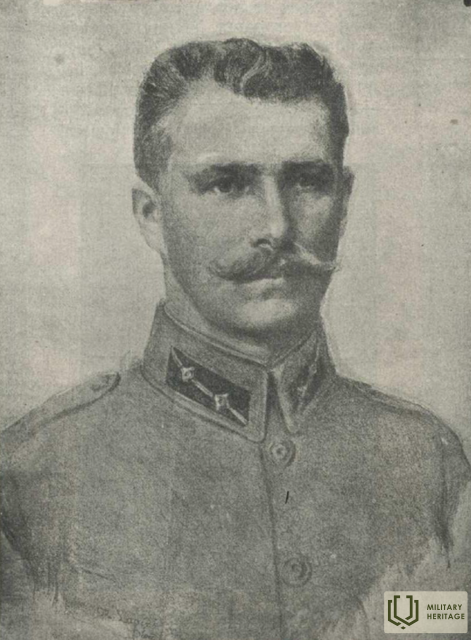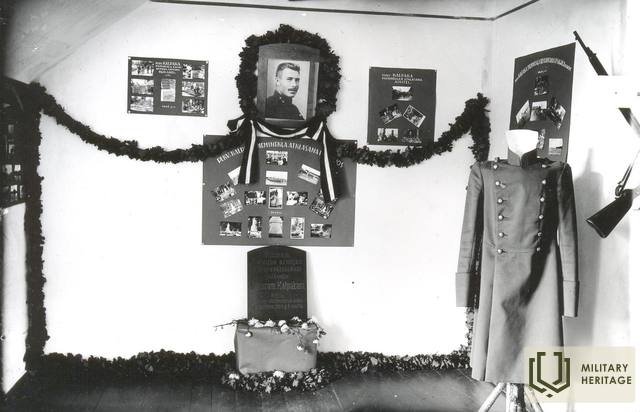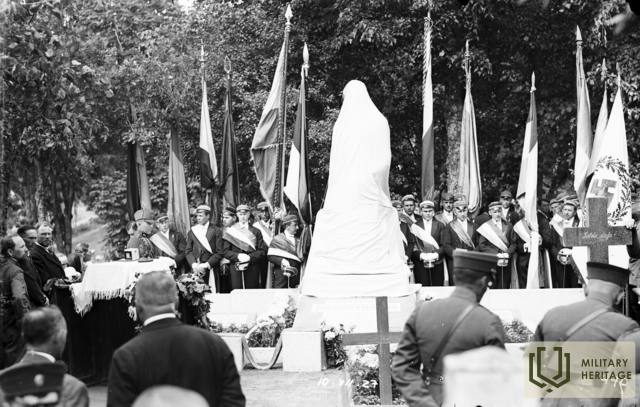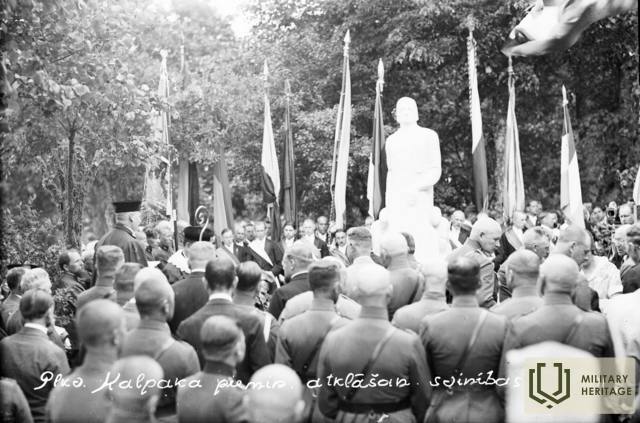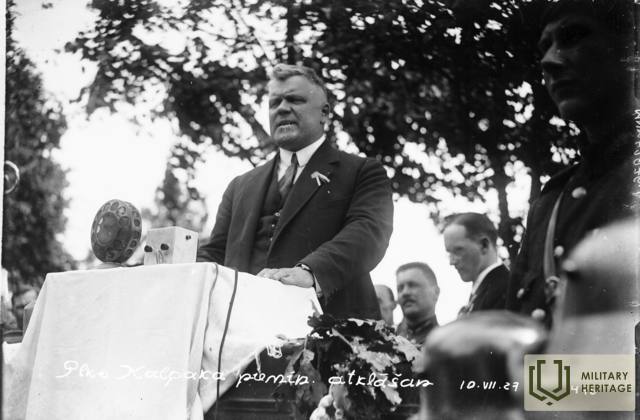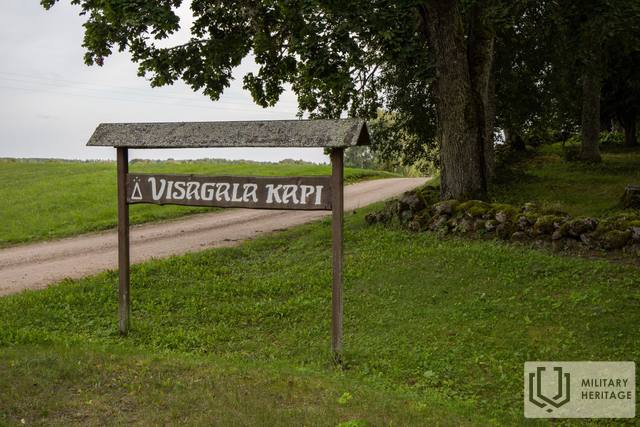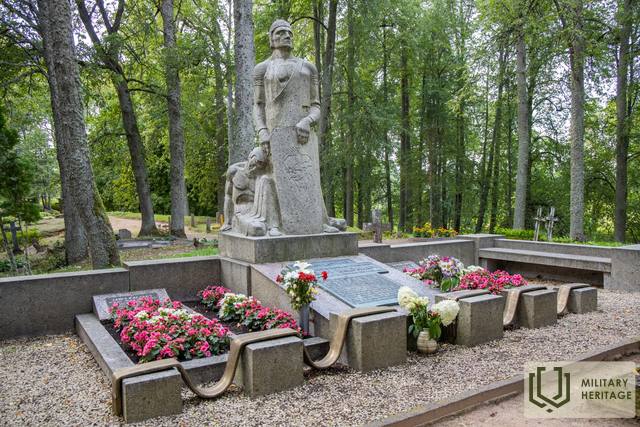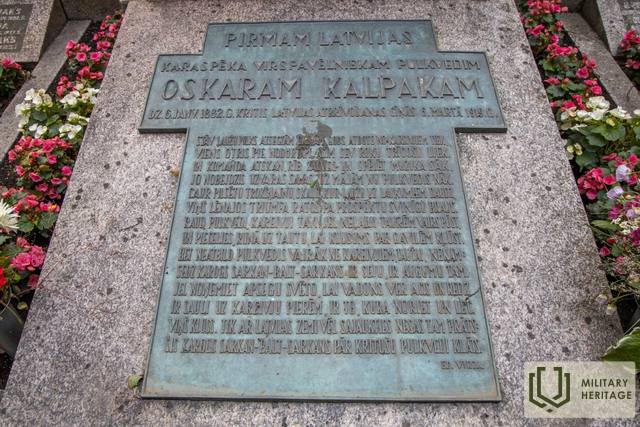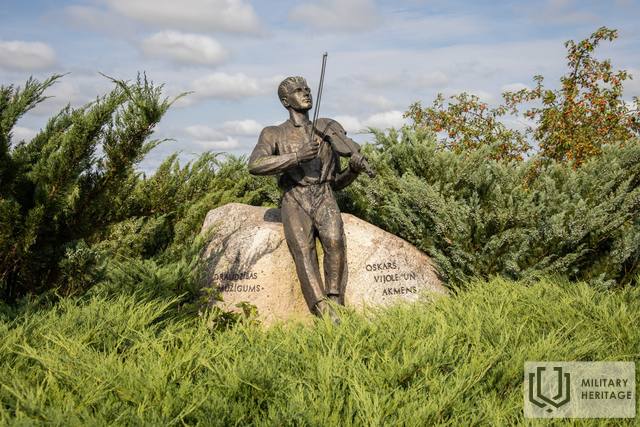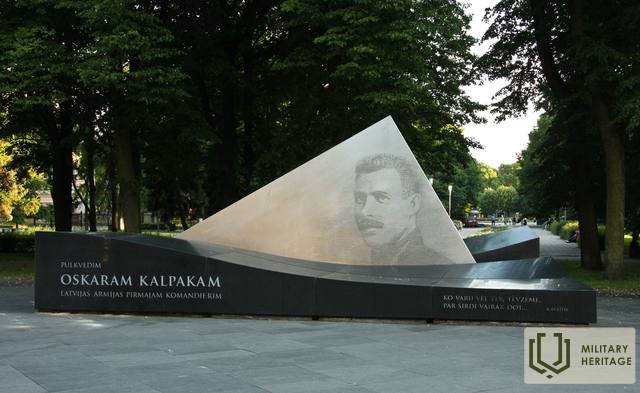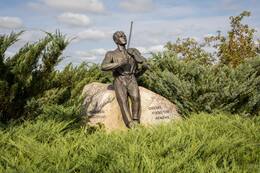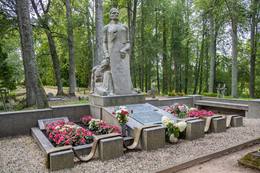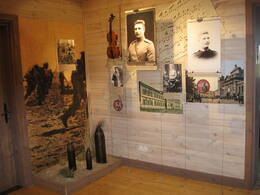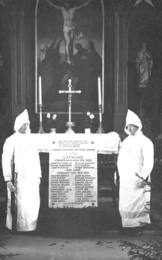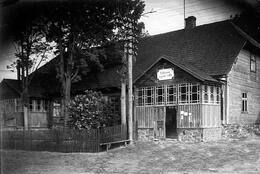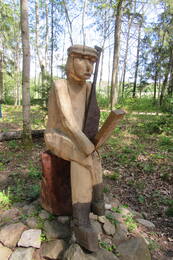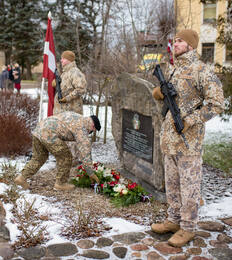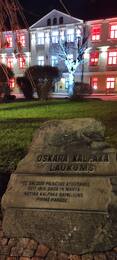In memory of Oskars Kalpaks
The memory of Oskars Kalpaks is preserved in many places – this is evidenced by his native Liepsalu house, a monument in the Visagala cemetery, commemorative events and beautiful concerts on March 6, the Meirānu Kalpaks Elementary School, streets in Lubāna, Madona and other cities, and on and on. But in this article – about the preservation of the memory of Oskars Kalpaks in his native region in the 1920s–1930s.
Edvards Virza on Oskars Kalpaks' childhood
Oskars Kalpaks (January 6, 1882–March 6, 1919) was born in Liepsala, and the poet Edvards Virza describes his childhood as follows:
“Oskars Kalpaks grew up in his family home as a resourceful, lively and healthy boy. What he first saw around him was an active rural life, slow, stubborn and persistent. The attractiveness of the surrounding nature, the poetic and ancient Aiviekste, the spruce forests that hissed like great waters during a storm and dried up like the laments of a tormented spirit in a light wind, the tales and stories, the humming of the cart on long winter evenings, did not allow the boy’s soul to become dull. He was often seen sitting on a large stone on the edge of the Sauki swamp and watching the clouds as they, carried by the wind and pierced by the golden spears of the west, rushed over the forest edges. Here, a few years later, when he entered the ministry school, he loved to play the violin, extracting all kinds of melodies from it. This stone, the dream of his childhood and youth "The pedestal was to become the pedestal of his eternal glory a few decades later."
The school is named after Kalpak.
O. Kalpaks' first school was in Visagala. His relative and childhood friend Otto Rutkis told about his school days in the newspaper "Brīvā Zeme" in 1939: "When we were growing up, our fathers had little money, but a lot of hard work. When we started going to school, Kalpaks was the biggest mischievous boy in the first grade, because he did well in all his studies and had a lot of free time. In the second year, he was already the class supervisor and with his determined strictness he gained all the respect and remained the supervisor throughout the school years."
Visagala School moved to Meirāni in the 1925/1926 school year. According to archive materials, the issue of changing the name of the Meirāni 6-grade elementary school was first on the agenda of the regular meeting of the Meirāni Parish Council on October 26, 1928. The meeting was chaired by the chairman of the council, Ernests Draguns. The application for the name change was received from the school council. Taking this into account, as well as after listening to the opinions of several public organizations, the parish council unanimously decided to rename its 6-grade elementary school to the Commander-in-Chief of the First Latvian Army, Colonel O. Kalpaks 6-grade elementary school. The 14 members of the parish council present voted for it (Augusts Kamols was absent): Jānis Akmens, Jānis Birziņš, Ernests Baltais, Arvids Drinkens, Oskars Kalve, Eduards Kalpaks, Alberts Kalpaks, Pēteris Kalve, Kārlis Pētersons, Alfreds Rudzons, Otto Rutkis, Jānis Sams, Kārlis Vanags.
However, the school name change did not happen so quickly. The Madona County School Board did not consider the long name appropriate and asked the Local Government Department for consent to name the school Meirāns Kalpakas 6-grade elementary school. On February 26, 1929, an article was published in the “Monthly of the Ministry of the Interior” indicating for general information, “What should be observed when changing school names”, and mentioning the Meirāns school. The department announced that there could be no objection to honoring the memory of Colonel Kalpakas, but pointed out that since the school is real estate that belongs to the parish, it is necessary for the county board to decide whether the change in the name of the school as real estate should be registered in the land register or whether it will apply only to the school as an educational institution. If you want to rename a school as real estate, you must request the consent of the Minister of Internal Affairs, first sending the decisions of the parish and district governments and extracts from the land registers regarding the school's current name to the ministry.
The Madona County Board, at its regular meeting on March 27, 1929 (chairman of the board A. Mūrnieks and board members A. Reipolts, T. Stange, J. Jansons and A. Spalviņš), in response to the decision of the Meirāni Parish Council of the March 13 meeting, decided to confirm the decision of the Meirāni Parish Council and, since the land plot allocated to the parish municipality from the state fund land has not yet been registered in the land register, to agree to the renaming of the school property in the name of Colonel Kalpaks. And so, starting from the 1929/1930 school year, the school was called the Meirāni (parish) Kalpaks 6-grade elementary school.
Museum values at Meirānu Kalpakas Elementary School
The school also housed the Oskars Kalpaks Museum, or rather, a memorial room or corner. The school is said to have housed a bench on which Kalpaks sat in his first school years at the old Visagala Elementary School. The picture published in the newspaper “Daugavas Vēstnesis” in early 1940 allows us to draw more detailed conclusions about the objects in the school’s memorial corner: a photograph of Oskars Kalpaks, framed and decorated with garlands of greenery and probably red-white-red ribbons, a number of other various photographs, two rifles and two army overcoats, as well as a helmet. The memorial corner also contained a gravestone that had been on Oskars Kalpaks’ grave until the monument was unveiled, and, possibly, ribbons from the wreaths laid during the reburial. Something was also exhibited in a display case behind glass, but some things cannot be really deciphered. An idea of the content of the photographs is given by the picture of the O. Kalpaks memorial corner in the collection of the Madona Museum. The memorial corner contains photographs of the laying of the foundation stone for the monument at the Visagala cemetery, then a series of photographs of the unveiling of the monument and also of the unveiling of the monument in Airītē. There are also other photographs, for which it is not possible to say exactly what is depicted in them. The memorial plaque on the grave reads: “To the First Commander-in-Chief of the Latvian Army, Colonel Oskars Kalpaks, who fell in the Battles of Liberation of Latvia near Airītēm on March 6, 1919.” This memorial plaque is still kept at the Meirānu Kalpaks Elementary School. Until the unveiling of the monument, the plaque was in the cemetery on the base with the text: “The foundation stone of the Colonel O. Kalpaks monument on June 14, 1925.”
Foundation stone dedication for the O. Kalpaks monument
On June 14, 1925, the foundation stone of the monument to Oskars Kalpaks was consecrated in the Visagala cemetery. The press wrote about it: “June 14 was a great holiday. In the morning, the gravestone of our national hero Kalpaks was consecrated in the Visagala cemetery in Meirāns, with the participation of the Prime Minister, the Minister of the Interior, the Minister of Foreign Affairs with his wife, and General Balodis. The people of Meirāns received the distinguished guests very warmly. The guests also stayed for a while at the Meirāns' green ball and then went to the town of Madona, where the parade of the Madona County Guard Regiment took place. Prime Minister Celmiņš accepted the parade and awarded prizes to the best riflemen.
Among the awards was one from the Minister of Foreign Affairs, Mrs. Meierovics, and one from the Minister of the Interior, E. Laimiņš. After the parade, the writer Sauliets gave a lecture "on what we Latvians must protect" and emphasized that we must especially protect the virtues of our ancestors. The lecture was followed by a concert by violinist Taube and piano artist Osis. The celebration ended with an honorary banquet and ball." Other publications, however, specify this event, informing that the foundation stone of the monument was consecrated. And G. Mīlbergs writes not so sweetly about this event in "Aizzragā": "For the guests of honor - a joint dinner was organized, to which the fathers of the Madona town had considered it possible to invite only the regiment commander and adjutant from the entire guard regiment, approximately 400 participants. Thanks to this, a tragicomic situation arose: speeches were made, congratulations were given to the defenders, and a small glass of wine was drunk from the cup of honor won by the defenders of the 1st Battalion, but the defenders did not hear or see it: they wandered around the defenders or drove home with a sour mind... The guests of honor also felt quite awkward.
From the Visagala castle mound
Of course, the unveiling of the monument by sculptor Kārlis Zāle and stonemason Arnolds Dzirkalis at the Visagala cemetery on July 10, 1927 was noteworthy. In the 1930s, it was popular to visit various historically significant places in Latvia, experiencing it as a pilgrimage. After the unveiling of the monument, Meirāni, the Visagala cemetery, the Kalpakas school also became such places for O. Kalpakas, and travelers often stopped by Liepsalā. Interesting travel descriptions of a visit to Kalpaks' homeland can be read in several newspapers from the 1930s: "From Meirānu station, the road first winds through still snowy fields to the Visagala cemetery. There the colonel rests in eternal peace. There an old alley indicates that the colonel was also taken to his final resting place along it. The cemetery itself is located on a long, small hill with two mounds. On one of the mounds, the Kalpaks gravestone, sculpted in the image of an ancient soldier, can be seen. From the Visagala castle mound, a wide area is visible: forests, swamps and snow-covered rural villages. Right next to it is the Liepu hill, which is also called the Gallows hill. Behind the cemetery to the left is the church hill. Also towards Aiviekste, the old Visagala elementary school building is visible, where Colonel Kalpaks received his first education. A monument has also been created here from a large stone from the Sauka bog."
Travelers at Kalpak Elementary School
Another journey tells of what he saw at the school: “It is already very dark and sharp morning, driving snow into my eyes, when I get off at Meirānu station. Bright lights are shining in the windows of a house on the hill. I go there. — “That is Kalpakas Elementary School,” a little boy I meet on the way tells me. It turns out that he is a student of Kalpakas Elementary School. Listening to his cheerful language, we have arrived at the school without noticing. The school principal, A. Drinkēns, who is entrusted with raising the students of this school in the heroic spirit of Kalpakas, kindly opens the door and gives the late guest a place to stay under the wing of this great school. The landlady, Kalpakas’ goddaughter, the eldest daughter of his brother Kārlis, is equally hospitable. Also here is Kalpakas’ brother’s son Roberts, who will graduate from elementary school this year and then continue his education at an agricultural school. With him grows a confident and worthy future caretaker of Kalpakas’ beloved “Liepsalu”. With great respect, Roberts shows me and tells me about the Kalpak violin, which is now in his possession.
In the morning, the school principal A. Drinkēns shows me the room with the Kalpaks memorial corner. “Most of his belongings are in the war museum. Kalpaks belongs to the entire Latvian people. But we have the opportunity to be near his life and resting place, to cherish and cherish his memory and to honor his name,” says the school principal. Then, through the meadows and forests along the banks of the Aiviekste, he takes me to Kalpaks’ native homestead — Liepsalā.”
About Liepsala
Oskars' brother Kārlis and his family farmed in Liepsalā. In a traveler's description, we read: "Here is an area rich in large forests and wide swamps; old and new houses among them. When we leave a thick cluster of spruce trees in a clearing, on a small hill we see a yellow-painted house with neat farm buildings. There are forests all around, and to the east lie the large Lubāns Plain. In these ancient houses I am led to the room where Oskars Kalpaks lived. On the wall between the windows are 3 large gravestones: Oskars in the middle, his father on one side and his mother on the other. Here is now a Kalpaks memorial corner, where some of his belongings have been collected. We sit down by the stove, where Kalpaks' bed used to be. Mrs. Kārlis Kalpaks says: "We all loved the colonel very much. When he came from Russia, he was going to stay permanently in Liepsalā. He went and helped everyone wherever he could. But then one day he came home from Lubāna so sad and thoughtful. He told his father that he was going to Riga to help the Latvian state. His mother prepared and even promised him warm clothes, but he refused everything and said: “What is at home will stay, but what is taken with him, God knows where it will end up!” The next morning, his father harnessed his horse and took him to Madona station. That was the last time we saw him.”
A traveler in Liepsalā also met stonemason Arnolds Dzirkalis: “The sculptor Dzirkalis also stays here, creating a bust of Colonel Kalpaks. Stories about Kalpaks’ childhood and youth are beginning to emerge. My brother says that the colonel based his life on dedication and work. When we visited Liepsalā, he always helped with all the housework. A special room has been set up in Liepsalā where Kalpaks’ belongings are kept. Most of the belongings have already been distributed to museums. The colonel’s violin and the collected sheet music are still in Liepsalā. A memorial grove can be seen in the field, planted by the junior group of the Kalpaks Elementary School in Meirānu. Further on, the Sauka swamp stretches, near which there was a large stone on which Kalpaks used to sit and play music with the neighboring youth in his youth. The Kalpaks monument was also carved from this stone.”
Another traveler was in Liepsala when it was still snowy: “It is a real Latvian house. Great simplicity, beauty and sincerity. In the garden, the snow-covered branches of hazel and other trees planted by Kalpaks bend over the walker’s head. The kind landlady of Liepsala, Mrs. Kalpaks’ brother Kārlis, receives a guest. While I am listening to the reminiscences, the owner Kārlis Kalpaks has also passed by. He had been to deliver grain at the Meirāni station. He says about his brother: “Oskars urged us all and called on us to be ready to join the ranks of the fighters at any moment. When he was leaving, he said: “Brother, you should come with me, but since you are weaker and cannot leave the house without your owner, it is better to stay here.” When he passed home, he was always and everywhere present when it was necessary to organize some snowball fights or other games. He had great strength and agility. When he grew up, he once worked in our house as a lime mixer for the bricklayers. He was paid 3 rubles a day, while others only 2 and a half rubles. The serf was not afraid of any work, he had no “ordinary and delicate” jobs.”
Second in Liepsala and Gaigaliesi
Travelers from the Meirāni side also stop at other places: “Further, my path leads to the other Liepsalā, where a close relative of Kalpaks, a contemporary and childhood friend, Otto Rutkis, lives. We sit down at the table where Kalpaks once sat. At that time, with a passionate speech, he urged all the gathered owners to fight.”
Kalpaks' cousin Alberts Kalpaks lived in Gaigaliesi. He tells about Oskars Kalpaks: “When Oskars came to our village, he was helpful to everyone. He would go with us to the forest to carry logs and break stones. He would lift a 14-foot-long and thick log like a sledgehammer. When he came from Russia, he was weak, but he still said happily: “It’s nothing, Latvian bread will make me better.”” And then the traveler went on: “Then across Aiviekste — along the linden and oak alley to the place where Kalpaks rests. We slowly climb the quiet cemetery hill. There, on the highest hill, stands the Kalpaks monument. On the grave are wreaths of pine and lingonberries. A gray boulder, shaped by the hand of a sculptor. In the distance, the blue Lubāna stream shines, in the distance the waters of Aiviekste flow quietly under the ice, but here, in silence under the stone monument, the Latvian freedom fighter Oskars Kalpaks rests in eternal peace.”
Memorial events in Meirāni
Memorial events for Oskars Kalpaks were organized on March 6, May 15, November 18, and other significant dates. On March 6, 1937, the Meirāni Guards Division and the Meirāni branch of the Latvian Aeroclub (which had an opening on that day) held a memorial service at the Visagala cemetery, and then a memorial service and a theater performance were held at the Meirāni People's Hall. In early March 1940, ten officers under the leadership of Colonel I. Kūlis, as well as guards from Madona, arrived at the Visagala cemetery for the solemn moment. In the evening, the celebrations continued at the Meirāni Kalpaks Elementary School.
O. Kalpaks' native land was also visited by the cadets. In 1939, 27 members of the cadet group of the Riga 2nd City Gymnasium with 4 leaders worked in the Ozoliņi camp of Meirāni parish. They worked in agricultural work - the girls thinned fodder turnips and beets and worked on hay harvesting. The boys repaired fences and did other work. But on their day off - Sunday - the cadets held a service at Kalpaks' grave, visited his first school and his native house.
From “Madonas Ziņas” we learn that a committee for the beautification of the Kalpaks resting place had been established, which would focus on improving the cemetery. In 1940, it was planned not only to be proud of the beautifully decorated resting place of O. Kalpaks, but also, taking into account that the cemetery itself was not exemplary, to make a number of improvements. It was planned to rebuild the chapel and install a gate near the highway, as well as rename the cemetery after Kalpaks. But – the name of Kalpaks began to be honored again only after less than half a century.
"Lubāna. The Next Hundred", 2020.
LNA Latvian State Historical Archives, F.380, A.1., L.406
Madona Museum of Local Lore and Art (MNM 38361)
Bebris, Raimonds. After a pilgrimage to the monument to Col. Kalpaks. Soldier. 07.08.1927.
In the homeland. Latvian Soldier. 27.11.1925.
I will decorate the resting place of Kalpak. Madonas Ziņas. No. 21. 06.06.1940.
In Kalpak's homeland – Meirāni. Rest. No. 696. 04.03.1938.
Kamols, A. Meirāni parish in the past and now. Parish Life. 15.11.1938.
What should be observed when changing the names of schools? Gazette of the Ministry of the Interior. No. 280. 26.02.1929.
LL Police Gazette. No. 46. 16.06.1925.
Members of the small detachment in the Lubāna clans. Free Land. No. 146. 04.07.1939.
Mīlbergs, G. What they promise and what they give. Aizzargs. No. 7. 01.07.1925.
OZ in the homeland of the Commander-in-Chief of the First Latvian Army. Week.24.07.1925.
Colonel Kalpaks saves an entire division. Daugavas Vēstnesis. No. 54. 06.03.1940.
Rn. In the homeland of Kalpak. Free Land. 03.03.1939.
Celebrations at the grave of Colonel Kalpaks in Meiran. Latvian Soldier. 16.06.1925.
VZ 1938. In the homeland of Colonel Kalpak. Morning. No. 63., 04.03.
Grasshoppers' Day in Kus. Madonas Ziņas. No. 21. 06.06.1940.
Related timeline
Related topics
Related objects
The birthplace of Colonel Oskars Kalpaks “Liepsalas” and the final resting place in Visagals cemetery
The Colonel Oskars Kalpaks family memorial in Liepsalas is located in the area between Madona and Lake Lubāns. Liepsalas is Kalpaks’ childhood home. The memorial site was established here in 1997 based on the ideas and using the resources of the colonel’s niece, Ārija Kalpaks-Grundmane (1922-2006). The site consists of various environmental objects and stone sculptures with a symbolic meaning, signifying Latvian ethical and patriotic values. The largest building houses an exhibit dedicated to the history of the Latvian War of Independence and the 22 years of Latvian freedom (1918-1940). Located in the Visagals graveyard, the monument to Oskars Kalpaks, created by Kārlis Zāle and Arnolds Dzirkals, was unveiled in 1927. The monument consists of a composition of three figures, in the centre of which is an ancient Latvian warrior holding a shield and a sword, with a falling soldier on each side. Placed obliquely on a granite base, a bronze plaque at the foot of the sculptural group contains engraved text, including a poem, dedicated to Kalpaks, by Edvards Virza. Oskars Kalpaks died on 6 March 1919 near Airītes, by the road from Skrunda to Saldus.
The final resting place of Colonel Oskars Kalpaks
Located in Visagala Cemetery, Madona County
On display is a monument to Oskars Kalpaks, unveiled on July 10, 1927, by Kārlis Zāle and Arnoldis Dzirkalis - a three-figure composition, in the center of which is an ancient Latvian warrior with a shield and sword in his hands, and on both sides of him are two warriors standing. At the foot of the sculptural group, a bronze plaque is placed obliquely on a granite base, on which is engraved a text that also includes a poem by Edvards Virza dedicated to Kalpaks.
Oskars Kalpaks fell on March 6, 1919, near “Airītē”, on the side of the Skrunda-Saldus road, and his remains were transferred from the Liepāja Northern Cemetery to the family cemetery in Visagala on September 18.
The monument was unveiled by the chairman of the Colonel O. Kalpaks monument committee, General J. Balodis, in the presence of the then President of the Republic G. Zemgalas, Prime Minister M. Skujenieks, Speaker of the Saeima P. Kalniņš, Minister of War R. Bangerskis and K. Ulmanis. The foundation stone of the monument was laid on June 19, 1925. The stone for the monument was taken from the colonel's native home in Siena Marsh, on this stone O. Kalpaks loved to play the violin in his childhood.
Oskars Kalpaks Museum and Memorial Site “Airītes”
The Oskars Kalpaks Museum and Memorial Site Airītes is located between Saldus and Skrunda near the A9 highway. The exhibit has extensive information about Colonel Oskars Kalpaks and his battalion, and shows the history of the Latvian National Army and the memorial site Airītes. The exhibit reveals Colonel Oskars Kalpaks as a personality, as a soldier and as a fighter for Latvia's independence. Audio logs in Latvian, English and German are also available as part of the exhibit. They emphasize the importance of the historic events of 1918/1919 in the protecting the statehood of Latvia. The museum building has been restored.
Entry is free; guided tour – for a fee. The complex has a recreation area, a park, an obstacle course, it is possible to take various classes, and there is a seminar hall for up to 30 people.
Memorial plaques for Lubāna residents who fell in World War I and the War of Independence at the Lubāna Lutheran Church
Located in Lubāna, Baznīcas Street 1, in the Lutheran church.
A white marble memorial plaque to Colonel Oskars Kalpaks, installed in the Lubāna church during the interwar period, can be seen. On June 22, 1924, a memorial plaque was unveiled in the church to the fallen students of Lubāna secondary school. In 1926, a memorial plaque installed by the Lubāna parish to the fallen residents of the parish was unveiled, as well as a memorial plaque to the Prime Minister Hugo Celmiņš, who was born in "Nagliņa" in Lubāna parish.
Materials about Oskars Kalpaks and Hugo Celmiņš's everyday life can be viewed in the exhibition of the Lubāna Cultural and Historical Heritage and Tourism Information Center.
Lubāna Municipality tourism and cultural heritage centre
The Lubāna Municipality Tourism and Cultural Heritage Centre is located in the very centre of the city of Lubāna. It features several exhibits, including permanent ones, on the history, culture and traditions of and events at the municipality. The permanent exhibits are dedicated to personalities that Lubāna is especially proud of. They introduce poet Broņislava Martuževa, member of the National Resistance Movement and political prisoner; politician Hugo Celmiņš, a participant of the War of Independence; Oskars Kalpaks, First Commander-in-Chief of the Latvian Army; photographer Alfreds Grāvers; opera singer Jānis Zābers; poet Jānis Gavars; artist Rūdolfs Pinnis, as well as folklorist and pastor Mārtiņš Celmiņš. A guide describes the lives of the Knights of the Lāčplēsis War Order and freedom fighters in Lubāna and its adjacent territory, as well as their resting places in Lubāna’s old graveyard. Available languages: Latvian and Russian. Guided tours with a German and English translation can be booked in advance.
"Nature - Strength Trail" of Oskars Kalpaks Museum
The nature trail was created in the territory adjacent to the museum and is based on the idea of the design of the O. Kalpaks Museum and its surroundings in 1936.The nature trail is free of charge for individual museum visitors.
The nature trail features wooden sculptures created during a woodworkers' plein-air workshop organised by the Kuldīga Technology and Tourism Technical School on the unifying theme - "For the Love of Freedom". Also on display are large-format paintings from the plein-air "Guard your Fatherland!" artworks painted by teams of schoolchildren from the surrounding regions.
A mini-air-track has also been created in the nature trail for the youngest visitors of the museum.
Battle of Skrunda Memorial and Flag Day
The Skrunda Battle Memorial is located in the centre of Skrunda, in Oskaras Kalpaka Park near the Skrunda Culture House, at the intersection of Kuldīgas and Liepājas Streets. In 2005, a stone was erected at the memorial commemorating the battle of 29 January 1919, when the battalion commanded by Oskars Kalpaks, together with the German and Russian units of the Landeswehr, liberated Skrunda from the Bolsheviks. The tradition of Flag Day has been maintained since 2004, commemorating the first town liberated from the Bolsheviks and its liberators, who raised the Latvian flag at the Skrunda church on 29 January 1919.
During the first months of the War of Independence, the Latvian Provisional Government, under pressure from the Bolsheviks, was rapidly losing territory. On 22 January 1919, the Bolsheviks captured Skrunda. A week later, in the early hours of 29 January, the offensive to recapture Skrunda began. The Latvian Separate Battalion under Lieutenant Colonel Oskars Kalpaks was to attack along the Rudbāržu-Skrunda highway and drive the Bolsheviks out of Skrunda. This would be followed by a flank attack by German units with the task of destroying the advancing enemy, while the Russian company would attack between the Latvian and German units, using the Skrunda church as a landmark. The attack was also supported by a German artillery battery. On the day of the attack, the frost was 15 degrees, the sun shone brightly, the Kalpaks had to cross a clear field, and the Bolsheviks were sheltering in the stone buildings of the manor. The Bolsheviks opened fire when the chain of attackers was about 300 metres away, a two-way firefight broke out, and the soldiers under Oskars Kalpaks' command advanced in a rapid advance, forcing the enemy to cease fire and retreat across the Venta. After about 3 hours of fighting, Skrunda was captured at about 9am, with the Latvian Separate Battalion having only 2 wounded.
The Battle of Skrunda was of great importance for the morale of the Latvian Provisional Government's armed Spek soldiers, as it was in fact the first significant victory in the battles against the Bolsheviks. Moreover, the commander himself, Oskars Kalpaks, showed particular courage in the battle, encouraging the soldiers by his example not to be afraid.
Oskars Kalpaks Museum and Memorial Site “Airītes”
The Oskars Kalpaks Museum and Memorial Site Airītes is located between Saldus and Skrunda near the A9 highway. The exhibit has extensive information about Colonel Oskars Kalpaks and his battalion, and shows the history of the Latvian National Army and the memorial site Airītes. The exhibit reveals Colonel Oskars Kalpaks as a personality, as a soldier and as a fighter for Latvia's independence. Audio logs in Latvian, English and German are also available as part of the exhibit. They emphasize the importance of the historic events of 1918/1919 in the protecting the statehood of Latvia. The museum building has been restored.
Entry is free; guided tour – for a fee. The complex has a recreation area, a park, an obstacle course, it is possible to take various classes, and there is a seminar hall for up to 30 people.
Memorial stone in Oskaras Kalpaka Square in Saldus
O.Kalpaka Square is located in the very centre of Saldus, at the intersection of Lielā and Striķu streets.
The former market square is today a favourite place of recreation for residents and visitors of Saldus, where concerts, commemorative events and festivities are held. On 10 March 1919, Saldus became the first Latvian town liberated by Colonel Oskars Kalpaks' battalion.
On 14 March 1919, the first parade of the Latvian Separate Battalion took place in the square, and in 1992, in honour of Colonel Kalpakas, the square was named after him.




